Sarah Sundin's Blog, page 450
December 7, 2012
Today in World War II History
70 Years Ago—Dec. 7, 1942: U-515 sinks British troopship SS Ceramic off Azores, 655 die, including nurses and 12 children. Battleship USS New Jerseylaunched at the Philadelphia Naval Yard, largest battleship in US Navy.
Published on December 07, 2012 03:00
December 6, 2012
Today in World War II History
70 Years Ago—Dec. 6, 1942: Germans victorious in tank battle at Djebel el Guessa, Tunisia.
Published on December 06, 2012 03:00
December 5, 2012
The Advent Wreath - O Little Town...
 One of my family's favorite Christmas traditions is the Advent wreath. On each of the four Sundays in Advent (the four weeks before Christmas), our family gathers around the wreath with cookies and eggnog and hot chocolate. Not only is this cozy family time, but it focuses us with joyful anticipation on the birth of Jesus.
One of my family's favorite Christmas traditions is the Advent wreath. On each of the four Sundays in Advent (the four weeks before Christmas), our family gathers around the wreath with cookies and eggnog and hot chocolate. Not only is this cozy family time, but it focuses us with joyful anticipation on the birth of Jesus.This Sunday, December 9, is the second Sunday in Advent, but it's never too late to participate. If you'd like to join the Sundin family in this tradition, here are some family friendly, kid-tested ideas. Adjust these to the ages of any children present to create a meaningful time for your family.
Advent Week Two - The Bethlehem Candle
Candles:
Light the first purple candle (the Prophets' Candle) and the second purple candle (the Bethlehem Candle) as shown. The purple symbolizes penance. Traditionally, the older children light these candles, but use your judgment.
Story:
Explain how the prophets foretold that the Messiah would be born in Bethlehem of the family of David. Joseph and Mary came to the little town, which was crowded with visitors for the census, and the only place for them to stay was in a dark stable.
Scriptures:
Micah 5:2 (the prophecy that Messiah would be born in Bethlehem)
Luke 2:1-7 (how Jesus came to be born in Bethelehem)
Matthew 2:1-11 (the Magi come looking for Messiah; the Jewish leaders tell Herod of the Bethlehem prophecy)
Songs:
"O Little Town of Bethlehem"
"Silent Night"
"Away in a Manger"
"We Three Kings"
During this hectic holiday season, may you find stillness and peace with the Child of Bethlehem.
Published on December 05, 2012 04:00
Today in World War II History
70 Years Ago—Dec. 5, 1942: President Roosevelt establishes Office of Economic Stabilization to control inflation. New song in Top Ten: “There Are Such Things.”
Published on December 05, 2012 03:00
December 4, 2012
Today in World War II History
 70 Years Ago—Dec. 4, 1942: President Roosevelt cancels Depression-era Works Progress Administration (WPA). US Ninth Air Force, based in Egypt, bombs Naples (Rommel’s supply port) in first US attack on Italy.
70 Years Ago—Dec. 4, 1942: President Roosevelt cancels Depression-era Works Progress Administration (WPA). US Ninth Air Force, based in Egypt, bombs Naples (Rommel’s supply port) in first US attack on Italy.
Published on December 04, 2012 03:00
December 3, 2012
World War II War Bonds
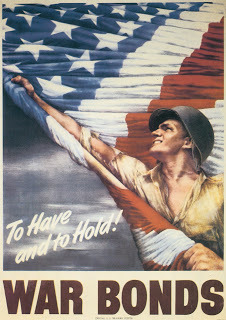 Seventy years ago this week, the United States held its first War Loan Drive. The Second World War cost the United States $300 billion dollars, with the federal budget rising from $9 billion in 1939 to $98 billion in 1945. How was the nation to pay for that?
Seventy years ago this week, the United States held its first War Loan Drive. The Second World War cost the United States $300 billion dollars, with the federal budget rising from $9 billion in 1939 to $98 billion in 1945. How was the nation to pay for that?Taxes were increased with an additional 5 percent Victory Tax. To assure payment, on June 10, 1943 the government approved the first automatic deduction of taxes from paychecks. But more was needed, and the government turned to bonds, which had been effective in World War I. War bonds were sold at 75 percent of face value (a $25 bond sold for $18.75) and matured over ten years. While the rate of return was below market value, bonds were a stable investment with the bonus of aiding the war effort. Channeling cash into bond purchases helped prevent inflation in the robust wartime economy as well.
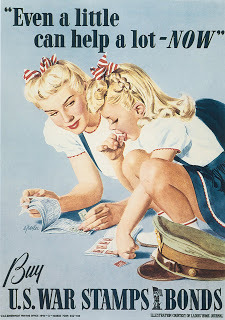 How Purchased
How PurchasedDefense Bonds first went on the market on May 1, 1941, and they were renamed War Bonds after the US entered the war in December 1941. Bonds were available in denominations of $25 through $1000, designed to be affordable for everyone. People could also purchase stamps for 10 cents, which were placed in special albums. When full, the albums were redeemed for a bond. War stamps were especially popular with children.
Employers set up automatic payroll deduction systems, so employees could set aside a certain amount for War Bonds with each paycheck. A robust advertising campaign, rallies and other promotions, and a series of War Loan Drives brought in even more needed money.
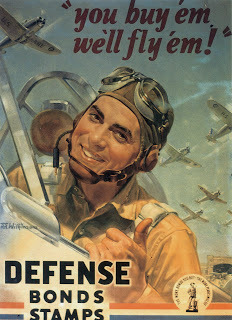 Advertising
AdvertisingAs part of the war effort, many newspapers, magazines, and radio stations donated advertising space and time. Posters sprang up in store fronts. Even comic books got in the act as superheroes promoted bond sales. Popular songs also encouraged sales, such as Bing Crosby's recording of "The Road to Victory" for the Sixth War Loan Drive.
Promotions
Bond rallies were extremely popular, featuring Hollywood stars and popular musicians. Celebrities conducted auctions - a kiss from Hedy Lamarr, Betty Grable's stockings, Jack Benny's violin, and the horseshoes of Triple Crown winner Man O' War. Movie theaters and baseball stadiums sometimes offered free admission with the purchase of a War Bond.
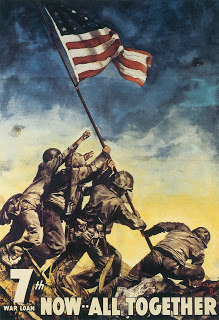 War Loan Drives
War Loan DrivesEight War Loan Drives were conducted from 1942 to 1945. Each was meant to raise an additional $9-$15 billion in sales. Towns received quotas, with the aim of promoting competition between towns. Volunteers went door-to-door, pleading for sales and rewarding purchasers with stickers to display on their window or door. The drives were conducted on the following dates:
First War Loan Drive: Nov. 30 to Dec. 23, 1942Second War Loan Drive: Apr. 12 to May 1, 1943Third War Loan Drive: Sep. 9 to Oct. 1, 1943Fourth War Loan Drive: Jan. 18 to Feb. 15, 1944Fifth War Loan Drive: June 12 to July 8, 1944Sixth War Loan Drive: Nov. 20 to Dec. 16, 1944Seventh War Loan Drive: May 14 to June 30, 1945Victory Loan Drive: Oct. 29 to Dec. 8, 1945
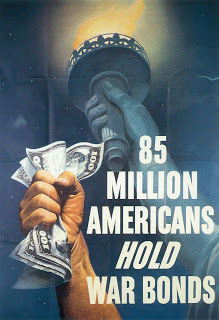
By the end of the war, 85 million Americans had purchased $185.7 billion dollars of bonds - over $2000 per person, when the average income was $2000 per year.
The patriotism and personal sacrifice of the average citizen played a significant part in the Allied war effort.
Published on December 03, 2012 04:00
Today in World War II History
70 Years Ago—Dec. 3, 1942: Germans reoccupy Tebourba, Tunisia, using Mark VI Tiger tanks for the first time in combat.
Published on December 03, 2012 03:00
December 2, 2012
Today in World War II History
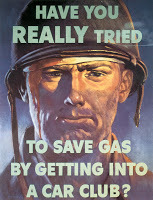 70 Years Ago—Dec. 2, 1942: Enrico Fermi starts first nuclear chain reaction at University of Chicago. President Roosevelt establishes Petroleum Administration for War to supervise oil industry.
70 Years Ago—Dec. 2, 1942: Enrico Fermi starts first nuclear chain reaction at University of Chicago. President Roosevelt establishes Petroleum Administration for War to supervise oil industry.
Published on December 02, 2012 03:00
December 1, 2012
Today in World War II History
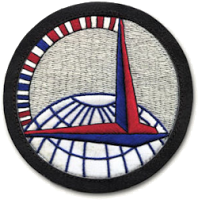 US Air Transport Command patch70 Years Ago—Dec. 1, 1942: Lt. Gen. Ira Eaker assumes command of US Eighth Air Force, based in England. Australians capture Gona, New Guinea. Control of “Hump” flights (India to China over the Himalayas) passes from US Tenth Air Force to US Air Transport Command. In the United States, gas rationing goes into effect nationwide. (See blog article: Gasoline Rationing in World War II).
US Air Transport Command patch70 Years Ago—Dec. 1, 1942: Lt. Gen. Ira Eaker assumes command of US Eighth Air Force, based in England. Australians capture Gona, New Guinea. Control of “Hump” flights (India to China over the Himalayas) passes from US Tenth Air Force to US Air Transport Command. In the United States, gas rationing goes into effect nationwide. (See blog article: Gasoline Rationing in World War II).
Published on December 01, 2012 03:00
November 30, 2012
Today in World War II History
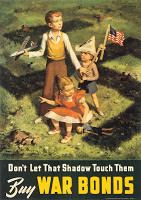 70 Years Ago—Nov. 30, 1942: In Tunisia, Allied offensive halts between Tebourba and Djedeïda due to inadequate air power. Battle of Tassafaronga: US ships repulse Japanese off Guadalcanal with heavy losses on both sides. Air Surgeon Gen. David Grant appeals to nurses to train as flight nurses. US First War Loan Drive begins, runs through 12/23.
70 Years Ago—Nov. 30, 1942: In Tunisia, Allied offensive halts between Tebourba and Djedeïda due to inadequate air power. Battle of Tassafaronga: US ships repulse Japanese off Guadalcanal with heavy losses on both sides. Air Surgeon Gen. David Grant appeals to nurses to train as flight nurses. US First War Loan Drive begins, runs through 12/23.
Published on November 30, 2012 03:00



